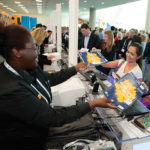Judging by the Thought Leader Summit that kicked off the IACC Americas Chapter 2011 Annual Conference on Wednesday, I’m not the only one who feels this way, because what was most notable about the lineup of panelists was their varied areas of expertise: Terri Breining, CMP, CMM, principal with the Breining Group and a practitioner of Meeting Architecture (read a Convene article about that here); Bob Dean, director of North American business for Profiling Online and a Certified Experience Economy Expert; Richard D. Flanagan, a trained psychologist, consultant, and author of The Six Disciplines of Breakthrough Learning: How to Turn Training and Development Into Business Results; Andrea E. Sullivan, a speaker, trainer, and instructional designer; Amy Wickenheisser, CMP, hotel manager for the Hamilton Park Hotel & Conference Center in Florham Park, N.J.; and Jeff Vredevoogd, director of education solutions for Herman Miller.
Their discussion around the topic of “Creating Compelling Meeting Experiences” — moderated by industry veteran John Potterton — wasn’t so much multidisciplinary as extra-disciplinary, with an emphasis on the many, many different ways that people learn. Conference centers themselves became part of the conversation — when they were mentioned at all — only as relates to how their design, layout, amenities, etc. facilitate (or impede) learning. A few of the many takeaways flying around the room at Gallaudet University’s Kellogg Conference Hotel in Washington, D.C.:
One meeting, many groups. The most popular room-set at Hamilton Park these days, Wickenheisser said, is a large session with seating broken into clusters or pods of six — “mixing lecture with brainstorming in small groups.”
What was so great about that? Meeting professionals need to do a better job of identifying their successes, Flanagan said, so they can replicate them. “You hear people say, ‘That was a successful meeting,'” he said. “Why? What are people doing differently and better as a result of this?”
Say that again. People come to a meeting for fresh content — but that doesn’t mean you can’t use webinars and other tools to begin introducing it to them before they get there. “People learn and retain,” Dean said, “when they get repeat exposure to the content.”
Halfway there. Hamilton Park doesn’t wait until guests and attendees are leaving to ask them about their experience; instead, the property uses a “mid-stay evaluation” to pick up on problems and fix them before people check out. “Oftentimes,” Wickenheisser said, “a mistake gives you higher results and satisfaction than just being good.”
Glengarry Glen Ross called it AIDA. Which reduced the sales process to four steps (that link is a bit NSFW): Attention. Interest. Decision. Action. Likewise, Flanagan pointed to five crucial steps in the meeting experience: Attracting. Entering. Engaging. Exiting. Extending. As in, attracting attendees; focusing on them as they’re entering your meeting environment; engaging them while they’re there; focusing on them again as they’re exiting; and extending the content and the community after the meeting. Maybe “AEEEE” it would sound better if Alec Baldwin were growling it out, but still, it’s a pretty good distillation of this thing of ours.



